They’ve been in Wyoming for 20 years. They are a challenge to hatch and have unique markings that make them easy to identify. Their benefits in the right environment are two-fold, and they can get big pretty fast.
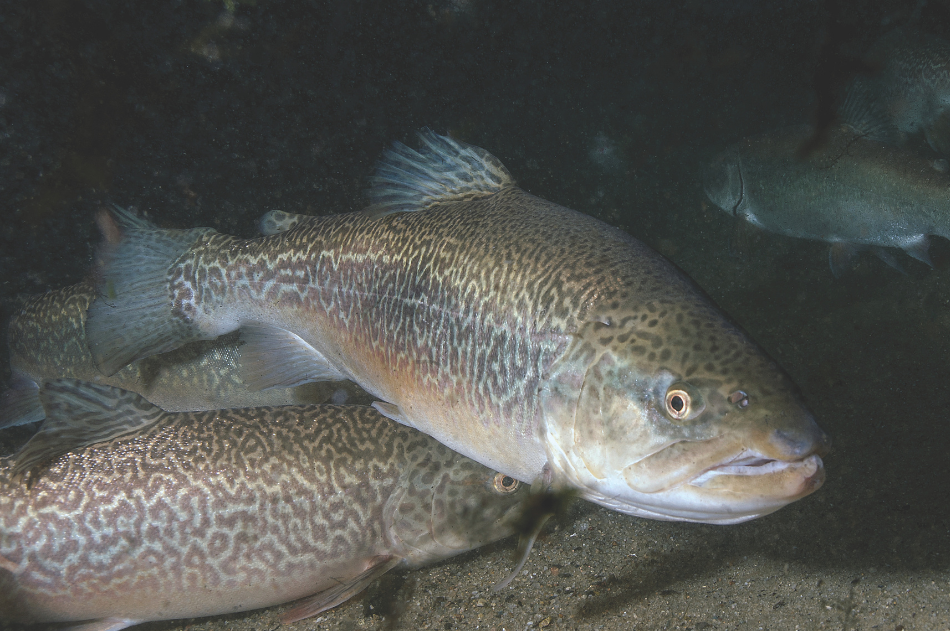
Tiger trout are sterile and can't reproduce on their own. (Photo by Michelson Underwater Photography)
In a nutshell, this is the tiger trout. This fish is a hybrid produced by crossing a female brown trout with a male brook trout. Tiger trout are sterile and can’t reproduce on their own. They have pronounced, dark markings that resemble the track of a worm — or tiger stripes — all over their brownish-gray bodies.
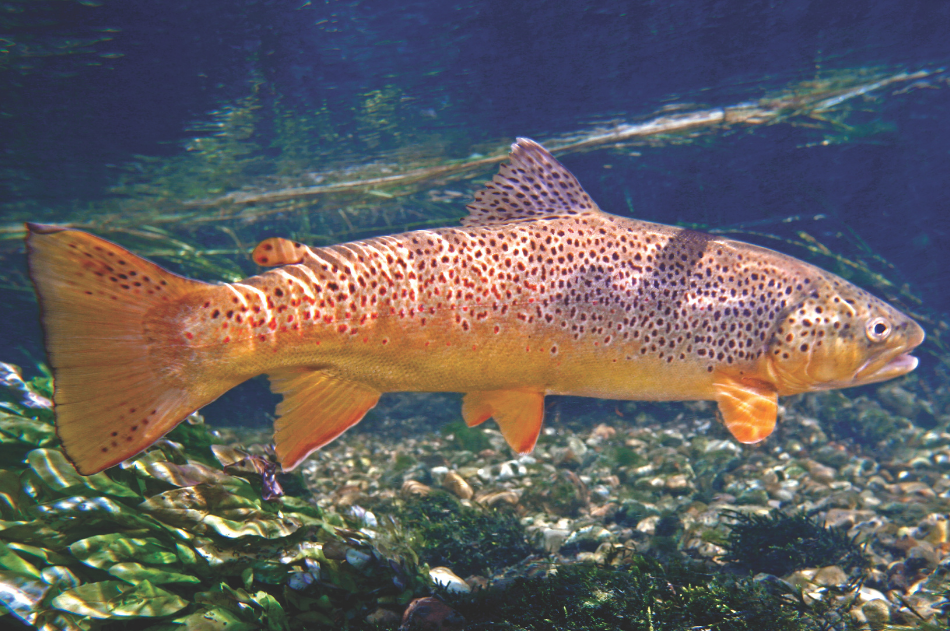
Female brown trout. (Photo by Patrick Clayton)
The first tiger trout in Wyoming were stocked in High Savery Reservoir near Baggs in late May 2005. At the time, High Savery Reservoir was only about a year old. The Wyoming Game and Fish Department got those fish from the Utah Division of Wildlife Resources. About 20,000 tiger trout were stocked that first year and the average size was 2.9 inches long. By July 2005, many of those fish were 6-7 inches long. By 2007, Game and Fish netted tiger trout in the 15-17-inch range, and by 2011 netting found fish 20-25 inches.
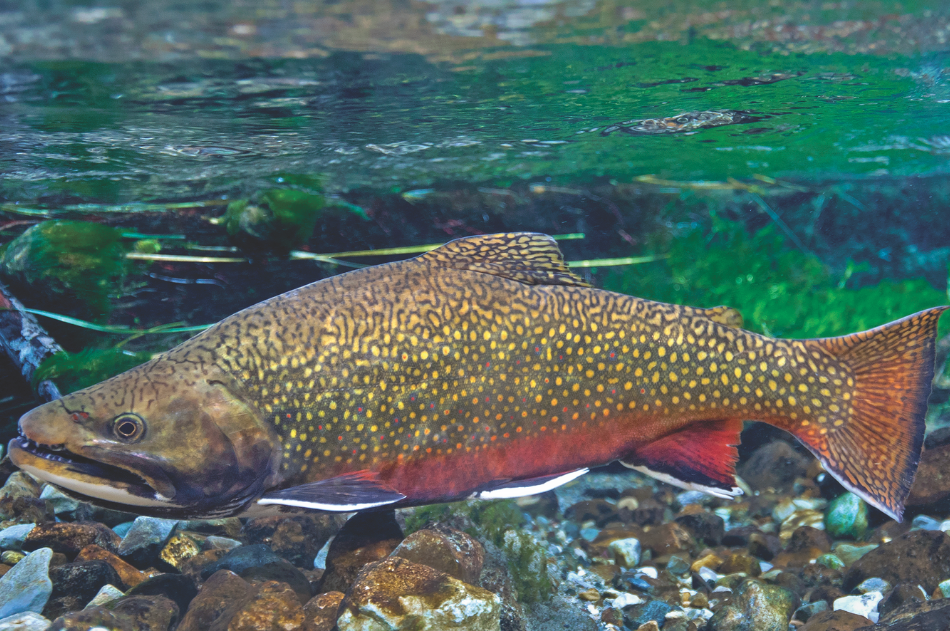
Male brook trout. (Photo by Patrick Clayton)
“They took off pretty quick, growing to catchable-size in two years and trophy size in six,” said Robb Keith, retired Game and Fish fisheries supervisor in the Green River Region who worked for the department when tiger trout were first stocked in High Savery.
The first state record for tiger trout was submitted in 2006 from High Savery at 1.6 pounds and 16.5 inches long. The record was broken regularly after that. Prior to 2023, the state record was 11.07 pounds and 28.8 inches long.
In 2014, tiger trout were stocked in Viva Naughton Reservoir near Kemmerer. In 2023, Owen Schaad of Cheyenne broke the state record with an 11.93-pound, 31-inch fish. Last year, Jaxon Krall of Kemmerer, who was 13 years old, broke the record with a 12.77-pound fish he caught from the shore of Viva Naughton. The fish was 31.25 inches long and had a girth of 16.75 inches.
The world record tiger trout was caught by Cathy Clegg in 2022 at Loon Lake near Spokane, Washington. The fish weighed 27.42 pounds, was 35.5 inches long and had a girth of 28.13 inches.
“I know of at least one fish that was netted from High Savery several years back that would have approached world-record status,” Keith said. “I’ve also seen pictures of tiger trout caught from High Savery years back that would have crushed even the current state record. Some people caught and released those big fish to avoid the notoriety of High Savery.”
Game and Fish doesn’t stock a lot of tiger trout in Viva Naughton annually — 15,000 each year since 2023. But last year, Game and Fish sampled seven tiger trout that were between 14.2-29 inches long, and the largest weighed 9.12 pounds.
“Tiger trout appear to be doing extremely well in Viva Naughton,” said Jessica Lockwood, Game and Fish fisheries biologist in Green River.
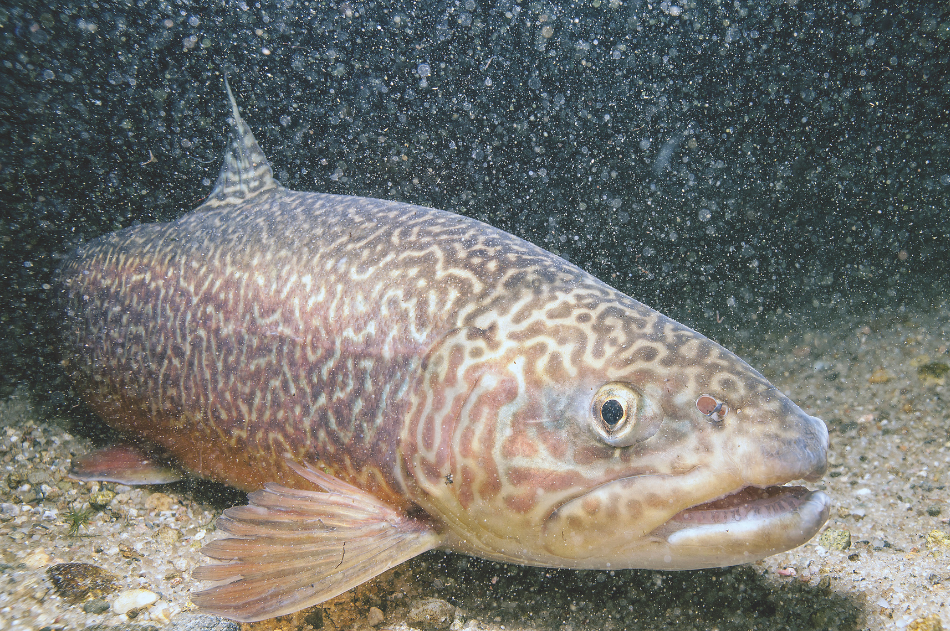
The first tiger trout stocked in Wyoming was in High Savery Reservoir near Baggs in 2005. Photo by Michelson Underwater Photography)
SO BIG, SO FAST
Tiger trout took off in High Savery and Viva Naughton because of food.
Even though the reservoir was new when tiger trout were introduced, there were a lot of white suckers in High Savery. Fish managers hoped tiger trout would take advantage of those sucker numbers, and provide a new sportfish for anglers.
The same can be said about tiger trout in Viva Naughton, but the problem fish was Utah chub.
Keith and Lockwood said there is little evidence tiger trout helped decrease white sucker and Utah chub numbers in High Savery and Viva Naughton, respectively. However, there is evidence of tiger trout eating these undesirable fish, and there are plenty of these nongame fish to go around. Tiger trout may not be reducing the populations of white suckers and Utah chubs, but this is still a win for fishery management and the anglers. Tiger trout are converting undesirable fish into desirable fish — large tiger trout. Anglers love to pursue large fish and tiger trout in both reservoirs get large eating the fish forage.
There also is no evidence that tiger trout are damaging other trout populations in these reservoirs, which include Colorado River cutthroat trout in High Savery and rainbow trout in Viva Naughton.
There’s one other benefit with tiger trout.
“One thing that makes tiger trout a really valuable management tool is they’re not fertile,” said Kevin Gelwicks, Game and Fish assistant fisheries management coordinator. “We can stock them in a water and don’t have to worry about them reproducing and overpopulating.”
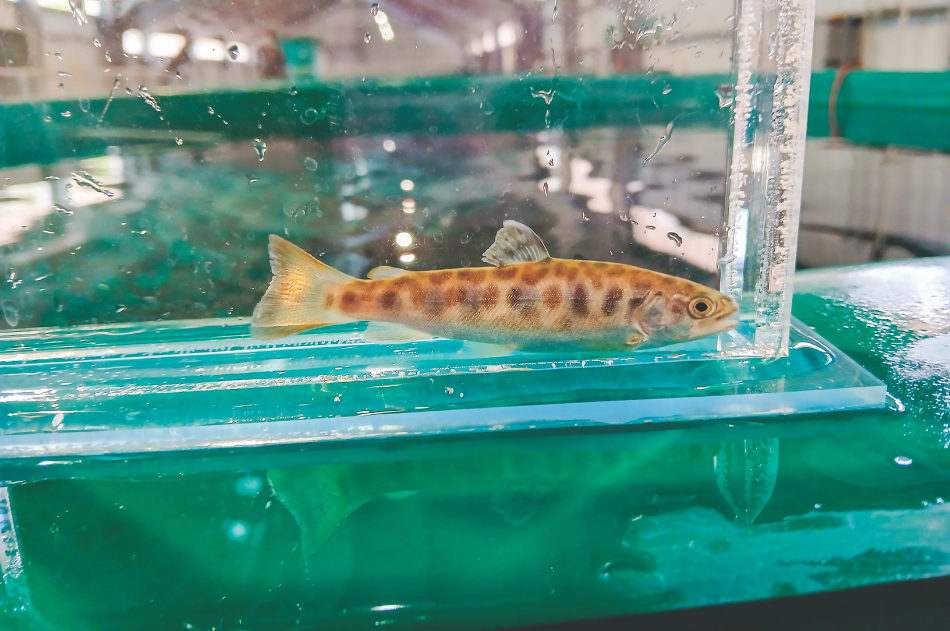
The Story Fish Hatchery in the Sheridan Region was the first facility in Wyoming to produce tiger trout in 2011. (Photo by Megan McLean/WGFD)
HOW THEY ARE MADE
From 2005-11 Wyoming received tiger trout from Utah, and a total of 92,860 tiger trout were stocked in six different waters throughout the state.
The Story Fish Hatchery in the Sheridan Region began producing tiger trout in 2011 and remains the only hatchery in the state to produce them. Story is one of only four state hatcheries in the United States to produce tiger trout eggs. The others are in Utah, Washington and Virginia. Story has provided tiger trout eyed eggs to 10 states as part of its trading program.
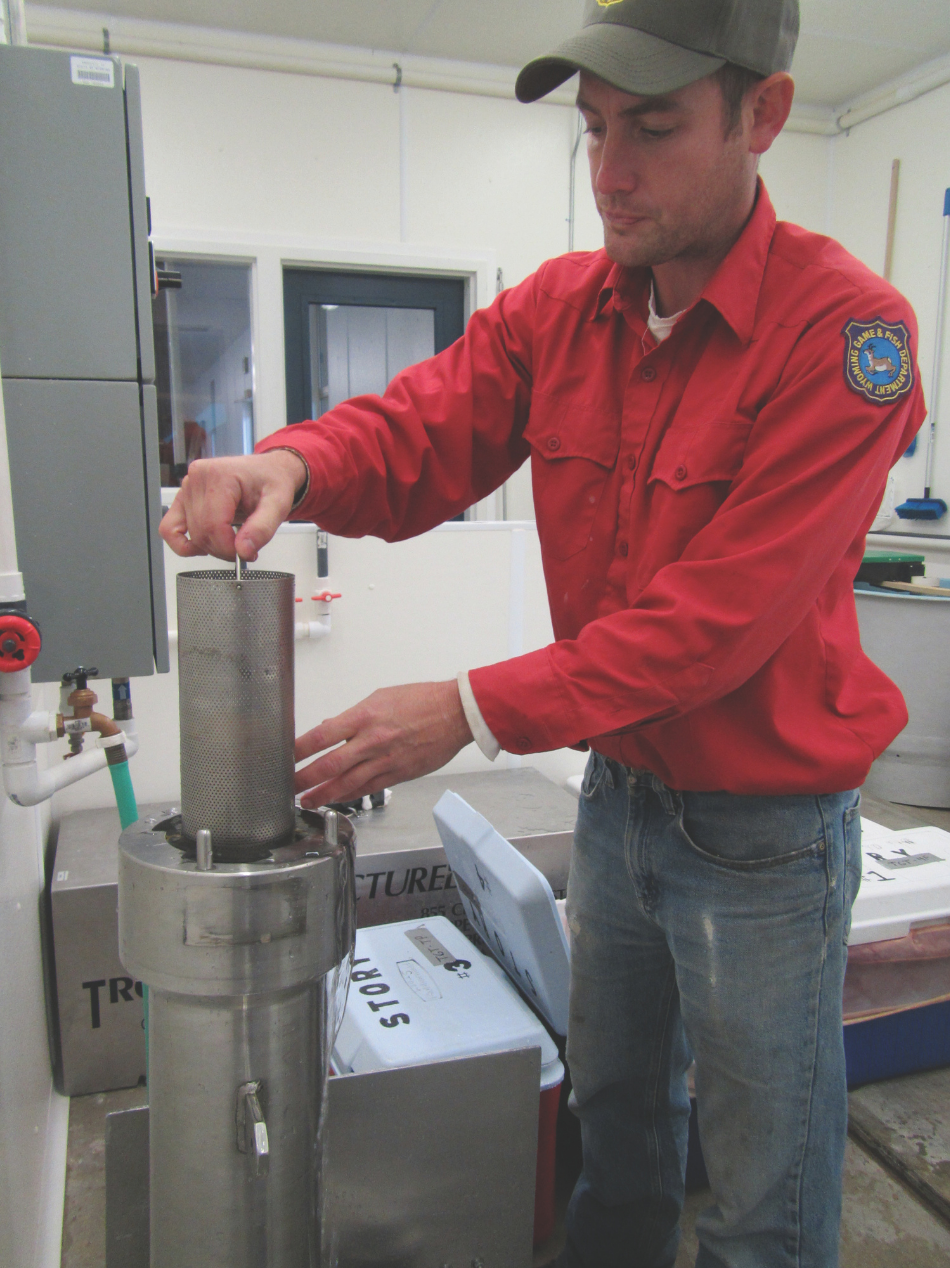
Nick Eglseder, senior fish culturist at Story Fish Hatchery, pressure treats tiger trout eggs to keep a chromosome that is normally ejected during egg development. (Photo by Steve Diekema/WGFD)
But making tiger trout isn’t easy.
Fish culturists create a triploid fish, which has three sets of chromosomes that make them sterile. Fertile fish come from eggs with two sets of chromosomes — a diploid. The genes of the tiger trout have not been manipulated or changed.
“Triploid fish simply have three sets of chromosomes instead of two and for this reason are not able to reproduce, but are otherwise normal fish,” said Steve Diekema, superintendent at the Story Hatchery.
Triploid tiger trout are created by forcing the egg to retain a chromosome that is normally ejected during egg development. This is done using a pressure shock treatment method. Normally, a chromosome is kicked out of the egg as a polar body in the early stages of egg development. Using pressure treatment at a specific time in the egg development, the polar body and chromosome are retained.
Story uses a small pressure chamber to induce triploidy in tiger trout eggs. After the eggs from the female and milt from the male are mixed to fertilize the eggs, the group of eggs is left to develop for 40 minutes. At exactly 40 minutes post-fertilization, the group of eggs is subjected to 9,500 psi of pressure for five minutes. Previous studies found that it is during this five-minute period at 40 minutes post-fertilization when the third chromosome is kicked out of the egg.
“This process is like an art and hard to do, but our people at Story are really good at it,” Gelwicks said.
Even though these tiger trout won’t be able to reproduce, this process produces more viable eggs than diploid eggs. Diekema said studies have proven this to be true, but why remains unknown.
In 2013, Story conducted its own experiment to compare the survivability of diploid versus triploid tiger trout eggs. Hatchery personnel found 72 percent of triploid eggs survived from the time the eggs were taken until the fish started to feed, compared to 54 percent for the diploid eggs. Diekema said since 2013, Story has refined its procedures and the survival rates of triploid tiger trout eggs is now even higher.
Today, Story produces approximately 750,000 tiger trout eggs per year. In 2011, the request for tiger trout eggs was 37,000. These eggs are produced once a year in October when brown and brook trout spawn. Diekema said it takes about two weeks to collect all the eggs.
“Although producing tiger trout eggs is an intensive process, we have been able to meet all requests for in-state production and out-of-state trading partners,” Diekema said.
STILL A BUZZ
In 2024, Game and Fish stocked 32 lakes, reservoirs and ponds with tiger trout. But right now, the hype with this fish is at High Savery and Viva Naughton.
“The buzz is still going, and it started with the first state-record fish caught in 2006,” Keith said.
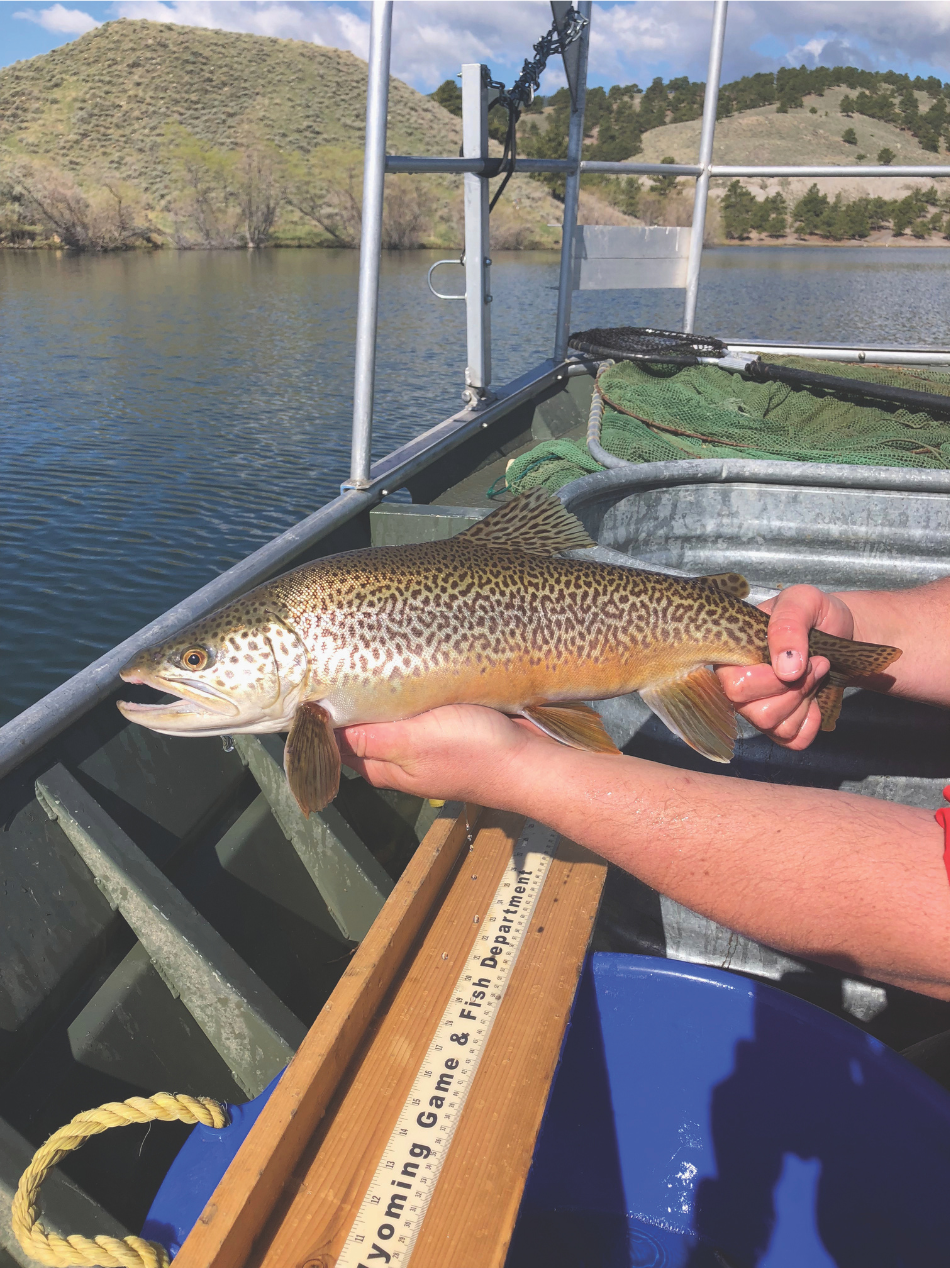
This tiger trout was caught during an annual spring sampling at Muddy Guard Reservoir No. 1 near Sheridan. (Photo by Gordon Edwards/WGFD)
Keith said he “has no doubt” there are bigger tiger trout in High Savery than the current state record. He also said earlier this year, Kemmerer Game Warden Alex Poncelet told him a lot of anglers are drawn to Viva Naughton for the chance at catching a trophy-sized tiger trout. Lockwood said it is “very possible” another state-record tiger trout could be caught from Viva Naughton in the near future. Keith is confident the next state record will come from High Savery or Viva Naughton.
“I have no doubt the current state record will be crushed by a fish from one of those two reservoirs in the next year or two,” Keith said.
A possible sleeper as a tiger trout fishery is the Kemmerer City Reservoir, just below Viva Naughton. Keith said fisheries managers know tiger trout are drifting out of Viva Naughton, entering the Hams Fork River and are likely in the Kemmerer City Reservoir. Game and Fish doesn’t stock it with tiger trout, but Keith added it has “exceptional forage” for tiger trout with macroinvertebrates and Utah chub. The reservoir is a quality rainbow trout fishery.
— Robert Gagliardi is the associate editor of Wyoming Wildlife.

